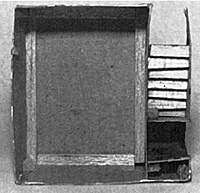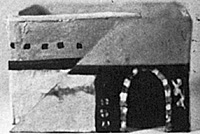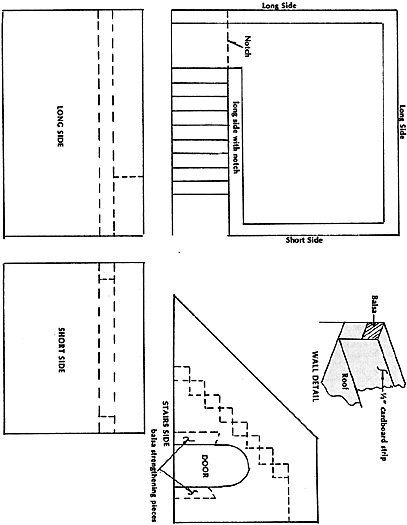 No matter what period you like, you'll love this building. I
made it as a house for the ancient period but the design is so
simple and versatile that everyone can use it. It will serve for
anything from a typical house in Mesopotamia, (for which it
was originally designed) to a modern blockhouse-gun
emplacement with some embrasure holes poked into it. It is
also easy to build.
No matter what period you like, you'll love this building. I
made it as a house for the ancient period but the design is so
simple and versatile that everyone can use it. It will serve for
anything from a typical house in Mesopotamia, (for which it
was originally designed) to a modern blockhouse-gun
emplacement with some embrasure holes poked into it. It is
also easy to build.
In ancient days such houses were made of sun-dried and sometimes kiln-dried brick. This "brick" was simply clay reinforced with straw. There were NO windows whatsoevr, and the smoke from cooking had to find its way out a hole in the roof or the wall. The doors were made of wattle or light wood, or even skins hung over the opening. the roof was constructed of light palm trunks laid over the walls, with reeds or fronds laid over them, and earth and clay tamped down on top. There was no foundation, the bricks being laid right on the ground.
 Quite often families would sleep on the roof to escape the
heat and stench of the ground floors. It was reached by a
ladder through a hole in the roof, or else by an outside
stairway. Inside stairways did not seem to be too common.
The outside of these houses were drab affairs, turning bleak
walls to the street. Quite often they were whitewashed to
reflect the heat of the sun better. Sometimes bands of color
were painted around the house (richer persons only).
Quite often families would sleep on the roof to escape the
heat and stench of the ground floors. It was reached by a
ladder through a hole in the roof, or else by an outside
stairway. Inside stairways did not seem to be too common.
The outside of these houses were drab affairs, turning bleak
walls to the street. Quite often they were whitewashed to
reflect the heat of the sun better. Sometimes bands of color
were painted around the house (richer persons only).
Militarily, houses in the ancient world are almost worthless. They form neither a very strong defensible point, nor afford anything other than protection. They can be knocked down or burned easily, and the only way troops can cause execution upon the enemy is when they are posted on the rooftops! Even then troops must be posted inside to prevent the enemy from entering, starting a fire, and forcing the troops upstairs off the roof.
In fact the only time I have read of them having any effect was in the Peloponnesian War. The main Spartan Army was away and the Athenians entered the Peloponnessus to attack Sparta, which was undefended and had no walls. The older and younger men, and the women hastily fortified the town by blocking the streets and connecting the outer houses, posting themselves on top. The Athenians took a look, thought better of it, and retired.
But ... wargamers will be wargamers ... so here it is. To make the house start by cutting 1/4" square balsa wood into the following lengths: 1 piece 3" long; 4 pieces 4" long; 2 pieces 21/2 " long; 9 pieces 1 " long; finally save 6 or 7 other pieces of various length for bracing.
Make a rectangular frame 3" by 4" using the 21/2 " and 4" pieces. Now cut out three card pieces the size of the LONG SIDE on the diagram, and one piece the size of the SHORT SIDE. On one of the "long sides" cut out the square (in upper right hand corner) marked by the dotted line. Glue this "long side" on the frame as shown in the top view, then glue the other sides on.
The notch on the long side will be where the top of the wall drops down to allow access onto the outside steps. Therefore it must be in the "interior" of the building and not on the edge. Note that one of the long sides will be protruding 1 " out from the edge, having glued it on one of the short sides of the frame. This protruding side is the one the cut out must face. Once in place securly glue the edges together at each corner and secure with the random scraps of wood glued to the inside corners.
Next cut out the STAIRS SIDE cutting out the opening for the door passage. Glue the nine one inch lengths in place as shown on the diagram to form the steps of the stairs. When these are nearly dry, glue the assembly onto the side with the notch (see figure). Make any adjustment before the glue sets, and firmly glue the edge of this wall to the protruding side. Let dry. Cut a piece of cardboard to fit the landing at the top of the stairs and glue in place. Bend a strip of cardboard 1" wide around the inside of the doorway. Glue it in place to make an arched passageway.
The remaining lengths of cut balsa are glued to the inside top of the three walls (not the stairwell wal I) with the appropriate lengths. This will give the wall apparent thickness.
Cut half inch strips of cardboard to the lengths of the inside of these walls and glue in place.
Paint as desired. I painted mine dun or khaki brown with a blue and red stripe around the entire building and "whitewashed" the lower half with a thin wash of white paint. I decorated the area around the doorway with dark paint and various bright colored designs.
If you wanted a little more detail cut small blocks of 1/8" balsa and glue these on to indicate protruding ends, much like the adobe villages of the American Southwest.

Back to Table of Contents -- Courier Vol. III #6
To Courier List of Issues
To MagWeb Master Magazine List
© Copyright 1982 by The Courier Publishing Company.
This article appears in MagWeb (Magazine Web) on the Internet World Wide Web.
Other military history articles and gaming articles are available at http://www.magweb.com